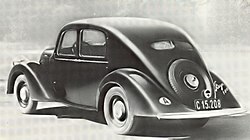Steyr 100
| Steyr | |
|---|---|
|
Steyr 100 sedan (1935)
|
|
| 100/200 | |
| Production period: | 1935-1940 |
| Class : | Middle class |
| Body versions : | Limousine , cabriolet |
| Engines: |
Petrol engines : 1.4-1.5 liters (23.5-25.7 kW) |
| Length: | 4370 mm |
| Width: | 1610 mm |
| Height: | 1550 mm |
| Wheelbase : | 2600 mm |
| Empty weight : | 950-1000 kg |
The Steyr 100 is a car of the middle class , which the Steyr-Daimler-Puch AG produced from the 1934th The moderately streamlined body was designed by director Karl Jenschke . The four-door cars had doors that closed against each other ( portal doors ; the front ones hinged at the front, the rear ones at the rear), whereby the center post - the B-pillar - was omitted.
The car had a 4-cylinder in-line engine installed at the front, which drove the rear wheels via a 4-speed gearbox. The front wheels were suspended on transverse leaf springs, the rear wheels had longitudinal leaf springs. Although not very powerful, the vehicles had no problems negotiating alpine passes, which is why they were not only highly valued in Austria . Franz Rehrl was the first to drive the Grossglockner High Alpine Road with a converted Steyr 100 on September 22, 1934 , on the unfinished road.
2850 copies were produced by 1936.
In 1936 the car was revised. He got a wider track and a bigger and more powerful engine. The new model was sold as the Steyr 200 and remained on offer until 1940. It was built 5040 times. A special technical feature was the light starting machine (combination of starter and alternator).
All the bodies of the Steyr 100 were made at the plant in Steyr and, with the exception of the wooden B-pillar of the convertible, are made of steel. At the Glas company in Dresden, only a "model body" was created on a Steyr 100 chassis, which was shown at the automobile and motorcycle exhibition in Berlin in 1933.
In Automobile Museum Aspang in Aspang-Markt in Lower Austria a Steyr 100 from 1936 and a Steyr 200 from 1937 is on display.
Technical specifications
| Type | 100 | 200 |
| Construction period | 1934-1936 | 1936-1940 |
| Superstructures | L4, Cb2 | L4, Cb2 |
| engine | 4 cyl. Row, 4-stroke | 4 cyl. Row, 4-stroke |
| Valves | standing (sv) | standing (sv) |
| Bore × stroke | 70 mm × 90 mm | 72.8 mm × 90 mm |
| Displacement | 1385 cc | 1498 cc |
| Horsepower) | 32 | 35 |
| Power kW) | 23.5 | 25.7 |
| consumption | 10 l / 100 km | 11 l / 100 km |
| Top speed | 100 km / h | 100 km / h |
| Empty weight | 950-970 kg | 990-1000 kg |
| Perm. total weight | 1390-1410 kg | 1430-1440 kg |
| Electrics | 12 volts | 12 volts |
| length | 4370 mm | 4370 mm |
| width | 1610 mm | 1610 mm |
| height | 1550 mm | 1550 mm |
| wheelbase | 2600 mm | 2600 mm |
| Front / rear track | 1240 mm / 1240 mm | 1340 mm / 1340 mm |
| Turning circle | 11.2 m | 11.2 m |
- L4 = 4-door sedan
- Cb2 = 2-door convertible
Gallery images
literature
- Werner Oswald : Deutsche Autos 1920–1945 , Motorbuch Verlag Stuttgart, 10th edition (1996), ISBN 3-87943-519-7
- Steyr Type 100. In: Allgemeine Automobil-Zeitung , February 1, 1934, pp. 27–31 (online at ANNO ).
Web links
- Video on the history and construction in the online archive of the Austrian Media Library ÖWF 1943 (11:43 min.)
Individual evidence
- ↑ Mirsching, Gerhard: Glass Cabriolets, a piece of German automobile history





